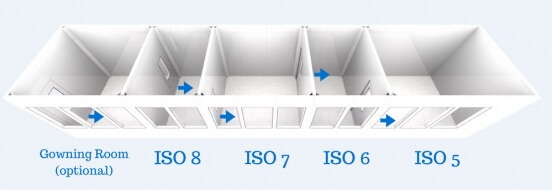Usp 797 and usp 800 cleanrooms for sterile and hazardous drug processes also have unique air change requirements.
Iso 7 clean room air changes.
A class 5 room can have an air change rate of 400 to 600 times per hour while a class 7 room can change at 50 to 60 changes per hour.
In reality however you can reach an iso 6 clean room with 1 recommendation is 2 airlock.
60 90 for iso 7 cleanrooms organisations typically measure micron sizes 5 0µ and 0 5µ.
Of ffus air changes hour 60 x cubic ft.
The large air supply is mainly provided to eliminate the settling of the particulate and dilute contamination produced in the room.
The chart below provides an explanation of the differences between our clean room classes.
The recommended air changes per hour for an iso class 1 clean room is 500 750 and the ceiling coverage should be 80 100.
In room ffu cfm cleanroom air change rates and tables for usp standards.
A flow hood within the primary control area does in fact influence the overall air change rate of the.
Whereas comfort air conditioning would require about 2 10 air changes hr a typical cleanroom would typically require 20 60 air changes and could be as high as 600 for absolute cleanliness.
The standard air flow rate for an iso 7 filtration system is 9 16 cfm per square foot.
In theory for an entire room to reach iso 6 air cleanliness you need to enter the cleanroom via an iso 8 ante room then go through an iso 7 to finally get into the iso 6 as shown in the image.
More air changes per hour are required for the better clean room class than the lower one.
Federal standard 209e equivalent.
A cleanroom must have less than 352 000 particles 0 5 micron per cubic meter and 60hepa filtered air changes per hour.
Class 10 000 associated eu gmp grade.
Iso class 3 500 750 air changes per hour with a ceiling coverage of 60 100.
Cleanliness of any clean room is maintained by the air changes per hour.
By minimizing turbulence lower airflow may improve cleanliness.
A properly designed clean room must have a high rate of air changes to scrub the room of particulates.
Lower air change rates result in smaller fans which reduce both initial investment and construction cost.
Information on iso 14644 1 2015 class 7 cleanroom classification.
Iso 7 is a common clean cleanroom classification.
A 30 percent reduction in air change rate results in a power reduction of approximately 66 percent.
As an example class 10 000 cleanroom filtration systems must provide filter coverage of 15 25 and a minimum of 60 air changes per hour.
Iso class 2 500 750 air changes per hour with a ceiling coverage of 80 100.
Iso 7 cleanroom applications.
C recommended air changes per hour ach.
See the maximum allowable concentrations by cleanroom class on our cleanroom classifications page.

